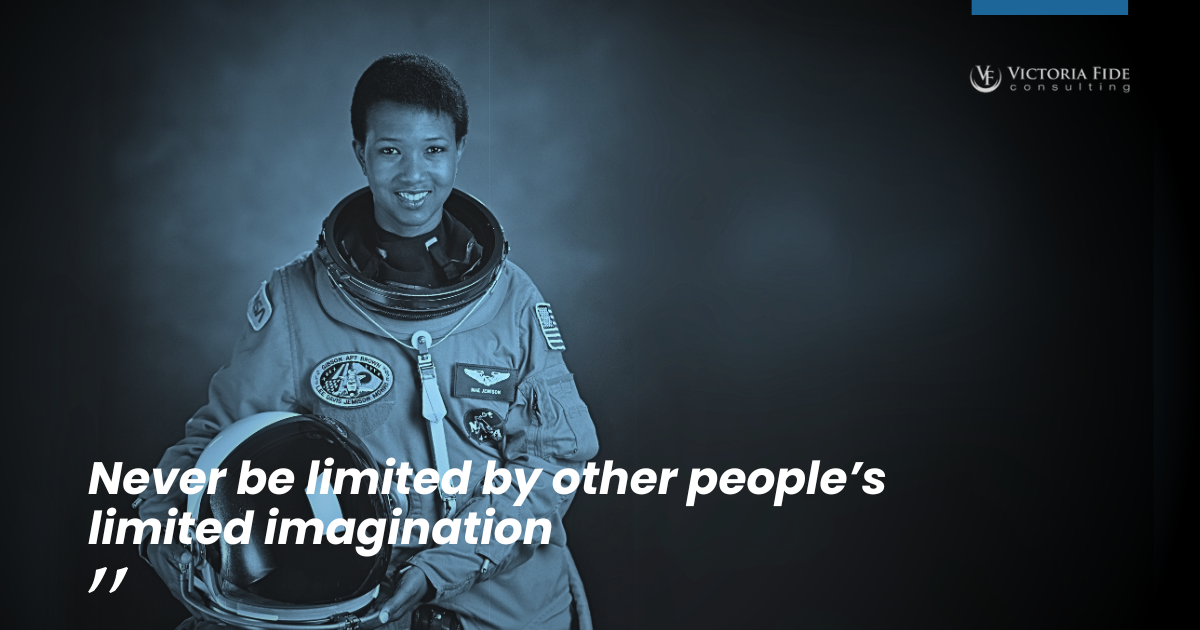
The Sage Wisdom series is produced by Victoria Fide Marketing with input and oversight from our leadership team and industry SMEs.
Dr. Mae Carol Jemison is a trailblazing figure in the fields of science, medicine, and space exploration. In 1992, she etched her name in history by becoming the first African American woman to venture into space aboard the Space Shuttle Endeavour. Beyond her significant contributions to space exploration, Dr. Jemison has made impactful strides in medical research, particularly on Hepatitis B.
She holds many honorary doctorates, has been inducted into both the National Woman’s Hall of Fame and the International Space Hall of Fame, and has founded a technology research company and a non-profit educational foundation. She even boasts a TV appearance in a 1993 episode of Star Trek: The Next Generation. Her commitment to pushing boundaries, coupled with her multifaceted expertise, firmly establishes her as a thought leader and a symbol of inspiration for many around the globe.
The life and accomplishments of Dr. Jemison highlight the significance of resilience, inquisitiveness, and the courage to envision possibilities beyond conventional boundaries. Her inspiring quote, “Never be limited by other people’s limited imaginations,” encapsulates her unwavering determination and belief in one’s potential to achieve greatness. When it comes to digital transformation, Victoria Fide challenges organizations to reach for the stars and break the mold of how things have always been done so that they can experience transformational change.
In this article, we will examine the difference between incremental change and transformational change, and discover what it takes to bridge the gap between them and push the needle of innovation. We will explore how to achieve the mindset required to spearhead transformational change, disrupt industries, and pave the way for innovation in the business landscape. Finally, we will examine how Victoria Fide’s proven process guides organizations in breaking free from limitations and embracing true, transformational change.
Incremental Change vs. Transformational Change
When discussing digital transformation (DX), it’s important to recognize the difference between incremental change and transformational change. Incremental changes are often surface level modifications that aim to enhance a system without making significant improvements to the business process. Incremental changes may be the addition of a new field for system tracking, implementing software updates, or creating a new report. While these changes can certainly bring about improvements, they tend not to disrupt the status quo or challenge underlying assumptions.
In contrast, transformational changes are deep, systemic shifts that fundamentally alter the way an organization operates. They are usually driven by a significant shift in strategy or a radical rethinking of an organization’s purpose. Examples include a company pivoting its business model, a government agency completely reworking its service delivery approach, or a retailer fundamentally changing its customer experience both in-store and on-line. These changes are seismic, with potential to disrupt industries and redefine norms.
The main difference between surface level and transformational change lies in the depth and scope of change. While surface level changes tend to be more about improving existing systems, transformational changes revolutionize the systems themselves. However, with increased potential for return, transformational changes also carry greater risk. Yet it’s these ambitious endeavors that have the power to catapult an organization into a new era of success and innovation. Like Dr. Jemison, businesses who dare to reach for the stars are the ones who break free from limitations and achieve true transformation.
Mindset: The Transformational Leader’s Secret Weapon
The success of any transformational change hinges on the mindset of the individuals leading and executing it. This is not merely about developing a positive outlook, but about fostering a growth mindset that embraces challenges, perseveres in the face of setbacks, sees effort as a path to mastery, learns from criticism, and finds lessons and inspiration in the success of others. This mindset empowers leaders to transcend traditional boundaries, question existing norms, and catalyze innovation within their organizations.

Free PDF Download
In the rapidly changing digital landscape, more and more companies are desperately trying to keep up with the competition. Download “The 10 Biggest Mistakes Businesses Make in Digital Transformation” for free today to learn how to use DX to radically transform your business and gain an edge over your competitors.
Dr. Mae Jemison’s groundbreaking achievements in science, medicine, and space exploration can be largely attributed to her forward-thinking mindset. Her unwavering belief in her potential and her refusal to be limited by others’ expectations propelled her to reach heights traditionally seen as unattainable. Her determination, fueled by a growth mindset, allowed her to face and overcome challenges, question existing norms, and ultimately revolutionize her respective fields.
Victoria Fide champions a similar mindset when it comes to DX initiatives, challenging leaders to move beyond surface level improvements and embrace transformational change. We advocate for adopting a culture of continuous improvement by challenging the status quo, analyzing business processes, and intentionally seeking feedback from users and relevant stakeholders. By adopting a mindset that welcomes challenges, learns from setbacks, and seeks innovative solutions, leaders can disrupt industries, redefine norms, and steer their organizations toward unprecedented success.
Overcoming Barriers to Transformation
As with any type of change, large transformations present barriers. Here are three common barriers to transformational change and how you can empower your team to overcome them.
1. Lack of Vision: Transformational change requires a clear and compelling vision. Without it, organizations may struggle to mobilize their people or maintain momentum when challenges arise.
Solution: Become a Leader with Transformative Vision
You must have a vision for what transformational change will look like for your company. Take time to envision how the organization will look and operate, without letting other people’s limited imaginations get in the way. This vision will serve as the foundation for decision-making and strategic planning. Victoria Fide’s Process for Transformational Change walks leaders through the steps necessary to define a concrete transformational vision for the initiative.
2. Limited Experiences/Exposure and Resistance to Change: People often resist changes that push them out of their comfort zones. This resistance can be especially pronounced if they have limited exposure to different ways of doing things. Long-term employees with 20 years or more at the same company may exhibit resistance to change due to their ingrained practices, while those who have witnessed diverse approaches across multiple organizations possess a broader understanding of effective strategies. They are generally more open to embracing innovative methods and exploring new possibilities.
Solution: Invest in Transformational Experts and a Comprehensive OCM Strategy
Engaging experts who have walked through multiple transformational initiatives will provide your team with the proper guidance and strategy for navigating the hurdles that accompany these types of initiatives. Implementing a robust Organizational Change Management (OCM) strategy can help mitigate resistance and build the necessary capabilities for change.
Transformation is not easy, but it doesn’t have to be impossible. Take control of your project’s success today and schedule a free 30-minute consultation to find out how Victoria Fide can equip you for transformational success.

3. Resources: Transformational change often requires significant resources, including finances, time, people, and space. Limited resources can pose a significant barrier to the implementation of transformational change.
Solution: Proper Resource Allocation, Planning, and Prioritization
Ensuring resources are effectively allocated, priorities are clearly defined, and plans for future projects are in place can help organizations overcome the barrier of limited resources. Thorough planning and prioritization can make a significant difference in successfully implementing transformational change.
Achieving Transformational Change: The Proven Process
Victoria Fide (VF) believes that discipline applied to the right process can result in positive, transformational change. As a result, we have developed a proven process for large transformational initiatives that provide organizations with high-impact results. This process is based on over 60 years of combined experience from our leadership team. Each phase is infused with activities designed to go beyond surface level, incremental change and reach true organizational transformation that alters the very DNA of the company. The three phases of Prepare, Execute and Sustain enable the organization to function beyond its previous limits and achieve its desired ROI and objectives.
The first phase of VF’s Process for Transformational Change is Prepare. This phase focuses on achieving a transformational vision, laying the groundwork to work toward that vision, and build a risk management plan to mitigate the larger risks associated with transformational change. The second phase – Execute – challenges the way things have always been done. In this phase, the project team surpasses the limits of others’ imaginations and makes strides toward innovation by reimagining processes, upgrading outdated systems, and designing innovative solutions.
The last phase – Sustain – enables the company to assimilate the change. This assimilation ensures the changes are effective, transformational, and sustainable for years to come. This phase also monitors whether the changes have made the desired impact and is producing the projected ROI. The Sustain phase assesses the transformative impact of changes and establishes a foundation for continuous improvement, preparing the company for success in future transformational initiatives.

Embracing Unlimited Possibilities
In conclusion, organizations that embrace transformational change have the potential to revolutionize industries and redefine norms. The impact of this type of change is far greater than that of incremental change, as it does not merely improve existing systems, but completely reimagines them. However, with the potential for greater return comes increased risk. To overcome the hurdles associated with transformational change, leaders must adopt a mindset of continuous improvement, define a transformational vision, and empower their team for success by leveraging transformational experts and an effective OCM strategy. Proper resource allocation, planning, and prioritization play a significant role in preparing for transformational change and laying the foundation for sustainable success.
If you are tired of being limited by other people’s imaginations, it is time to set your sights on the horizon and reach for greater heights. Take the first step toward transforming your organization by scheduling a free consultation with Victoria Fide’s CEO, Tory Bjorklund. Learn more about our proven Process for Transformational Change and how it can serve your specific DX initiative to help carry you to a brighter future. Like Dr. Jemison’s journey to space, the journey to true transformation in business requires the imagination to break free from limitations and the courage to envision and reach for the stars.
Subscribe to our weekly LinkedIn Digital Transformation Success newsletter and get notified of each new edition.
